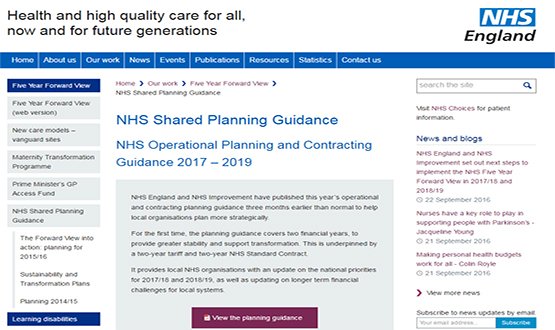NHS ‘to do’ list puts IT and funding focus on STPs
- 22 September 2016

The NHS ‘must do’ list, published today three months’ earlier than usual, indicates that there will be funding for Local Digital Roadmaps over the next two years.
The NHS Shared Planning Guidance, which is normally published in December, indicates that money will be allocated to Sustainability and Transformation Plan areas. These do not always align with the LDRs, which were set up earlier.
But the move is in line with the general direction of travel in the guidance, which places a big emphasis on the STPs as the vehicle for delivering the Five Year Forward View plan to close a £30 billion funding gap across the NHS by 2020-21.
The guidance says each STP will be “a route map for how the local NHS and its partners make a reality of the Five Year Forward View, and the spending review envelope [the money allocated to the NHS by the Treasury].
“STPs are more than just plans. They represent a different way of working, with partnership behaviours becoming the new norm. That’s why, although STPs are relatively new, we see them as having a significant role in the NHS.”
The guidance reiterates the main themes of the Forward View, that the gap between funding and demand will only be closed by a new focus on prevention and on new models of working. It stresses that these new ways of working must be “collaborative” rather than adversarial.
However, it says plans must take account of the financial ‘reset’ announced earlier this autumn, which imposed ‘control targets’ on many trusts, and put into special measures some organisations that had not signed up or were unlikely to meet them.
“To ensure that organisational boundaries and perverse financial incentives do not get in the way of transformation, from April 2017 each STP… will have a financial control total that is also the summation of the individual organisational control totals,” it adds.
“All organisations will be held accountable for delivering both their individual control total and the overall system control total” – although some flexibility may be allowed, if agreed by both NHS England and NHS Improvement (formerly Monitor).
The guidance hints at further changes to the organisation of IT at a national level. It says the £4.2 billion that health secretary Jeremy Hunt said would be spent on NHS IT over the course of this Parliament, and which it describes as “additional transformation for technology programmes” will be spent via a new approvals process involving the Department of Health, NHS England, and NHS Digital.
Also, that plans will be delivered by the National Information Board and a new Digital Delivery Board, that looks set to be an important player in confirming national and local plans.
For trusts and commissioners, the guidance says there will be two year contracts, tariffs and CQUINs to support longer-term planning.
The revision to the NHS standard contract will have implications for NHS IT, since it includes mandatory use of the new e-Referral system from April 2017 and mandatory data-sharing agreements for urgent and emergency care providers by the same date.
The contract will also require the NHS to comply with the new data security standards in the Caldicott 3 report by April next year, transmit discharge letters electronically, using structured messages and standardised clinical headings, from 1 October 2018, and implement “new interoperability requirements for clinical IT systems” from January 2019.
The guidance does not give any information on what the latter will be. Further IT implications from the guidance include “the daily submission of electronic SUS data from April 2018”, alongside a faster turn around of data from NHS Digital to trusts.
Launching the guidance, Jim Mackey, the chief executive of NHS Improvement said: “The NHS has a real challenge on its hands, but the action we are taking today will help the service pull together to make sure it meets the needs of patients well into the future.”




